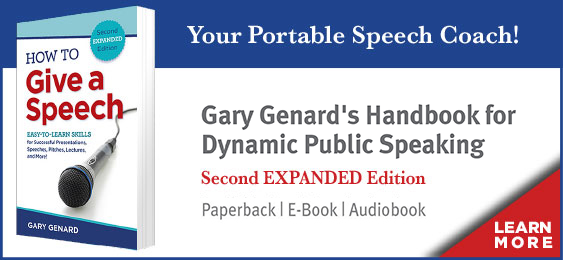Do you think PowerPoint is the most powerful presentation tool you can use?The real "tool of power" in speeches and presentations is much closer to home—in fact, no closer than the mirror.
It's you.
You are the prime influencer whenever you present, and nothing else is even a close second. Your physical presence, vocal expressiveness, the way you hold yourself and move, and how you relate to your listeners, constitute a presentation package that's literally evolved to persuade and inspire audiences like nothing else in the world.
If you'd like a few reliable tips on how to use PowerPoint more successfully, download my free cheat sheet, "5 Rules for Succeeding with PowerPoint."
Many times, even your content plays second fiddle to the intelligence and talents you bring to your speaking assignments. Yet for too many speakers, content still reigns supreme: so much so, in fact, that they neglect three critically important areas in preparing to speak influentially. Let's look at each in turn; for it is proceeding in the right order as you prepare a speech that ensures that your talk will be successful. I label these three steps Audience Analysis, Specific Purpose, and Engagement.
Understand Your Audience As Fully as Possible
At the public speaking workshops I conduct, I usually ask a member of the audience: "If I told you that you have to give a presentation next month, what would your first thought be?" The answer is usually: "What's my topic?"
Most of us would probably ask that question, wouldn't we? But there's another more important question to ask at this stage: not "What?" but "Who?" For until we know exactly who our audience is, how do we know what to talk to them about? The range of listeners for a topic we're expert on can range all the way from school children to industry insiders, and many gradations in between. The more you can understand the specifics of what this audience wants to know, needs to know, and how it prefers and expects to hear it, the better armed you'll be to influence them positively. Here are the steps to conducting a successful audience analysis.
Decide on Your Specific Purpose for Your Presentation
If you're a speaker who expends all of your energy gathering and shaping your content, you probably spend too little time thinking about your specific purpose. From an audience's point of view, being handed sheer data from a presenter is a lot less exciting than being moved by that speaker.
In that regard, remember that your job as a speaker is to affect these aspects of your audience:
- Their thoughts.
- Their feelings.
- Their actions.
And all three of those elements of an audience's reaction are usually in play at the same time. For instance, if I'm pitching my product to your company, I want to educate you on the product (your thoughts), I want you to feel that you're making the right decision, and of course I want you to go ahead and buy (your action).
As you consider your purpose along these lines, be as specific as possible, using an active infinitive verb: to inspire, to excite, to encourage, to win over, to challenge. Do you see how such verbs could shape the talk you put together? That's because the specific purpose you decide upon will determine the content you bring into your presentation. "To excite" an audience, for example, you will need to bring in, well, exciting content, a very different proposition than informing your audience about similar material.
Engage Your Audience to Be Fully Effective as a Public Speaker
If you've taken the two steps I've outlined above, you've analyzed your audience productively, and decided on a specific purpose that will help shape your content. By this point, you probably have an excellent understanding of your listeners, and have put together a strong presentation.
But you're not home free yet. As I mentioned earlier, the sheer delivery of information usually doesn't thrill audiences. In a sense, however, it is your job to thrill them. You can do so by deciding in specific terms how you're going to engage your listeners.
A few years ago, a medical professional engaged my services to coach her for a full-day training she was going to be conducting. When I asked her what the day's activities would look like at her workshop, she told me she'd be showing three PowerPoint presentations throughout the day. And that, I'm afraid, was it.
She hadn't considered how she was going to engage her listeners throughout that long day. You and I can't make that mistake. Once you've conducted your audience analysis, then, and determined your specific purpose—and put together your fabulous presentation to accomplish that purpose—it's time to ask yourself, "How am I going to keep my listeners interested?"
In addition to encompassing the three adult learning styles—visual, auditory, and kinesthetic—make a point of building in discussion, activities, exercises, role-playing and simulations, and other components meant to seduce your listeners into your dance. Start immediately, incidentally, as you grab your audience with one of the 12 foolproof ways to open a speech . . . and never let go.
Key takeaways from this blog:
- PowerPoint as a presentation tool doesn't equal you in terms of power.
- To create influence, know your audience and how you want to move them.
- Conduct an audience analysis to discover what turns these listeners on.
- Be as specific as possible in terms of the action you want them to take.
- Once you have excellent content, you must consider how to engage them.



